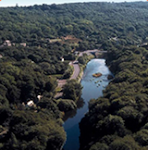But let's get the silly stuff out of the way first...
And not wishing to appear out of place by not donning a very colourful head garland...
The weekend started on Friday for the WuFuV's as we made our way to Forest Glen and then on to the Ercall's Quarry 5 to clear the areas of scrub, bramble, litter and pooey dog stuff in preparation for the next day's Wrekin Wakes.
Following a full day of that the WuFuV MuGs (for the uninitiated that's Wrekin Forest Volunteers Moth Group) had a moth night planned at Granville Nature Reserve so for some of us it necessitated a quick change, gathering up of moth equipment, moth pavilion and a bite to eat in order to be on site an hour before nightfall - but we all made it and the fact that none of the 27 keys given to me opened the main gate to the reserve didn't really matter at all!
We had a contingency plan - we headed for the furnaces where I've always wanted to run a moth-trapping. Incredibly one of the said 27 keys did in fact open the gate to that part of the reserve so it all fell into place really and in no time at all we were ready and waiting for the arrival of those little fluttery things of the night.
Enter Tony first though, flapping his arms to demonstrate to newcomer Becky how moths prepare for flight!
Or was that when we were getting ready to do the okey cokey? I forget. Margaret and Steve certainly seem to be up for it - oh... by the way you two; we made it for the Amen Corner/Searchers gig Saturday evening too - didn't spot you though!
Anyway the moth night passed all so quickly as we had to leave at midnight to be fairly fresh for the following morning and what in future years, I'm sure, will become a famous gathering of cheerful souls...
The Wrekin Wakes
There was a definite happy and somewhat nostalgically 'hippy' feel to the day
There was so much happening with 4 live acts on stage throughout the day including the wonderful harmonies of Luke + Cath, the superb voice and guitar playing of Claire Shaw, the great duo that are The Medicine Boys, The Vagabondi Puppets - great fun for all the little people and finishing with the very wonderful, the very tuneful and talented Day Level.

Luke + Cath

Claire Shaw
Day Level
And there was so much else going on too!
Did someone just hit the ball over the boundary?
No! That was the WuFuV's bug hunt, which started with just a handful of people and suddenly exploded! In the stampede to find what was in the undergrowth this little monster almost got trodden to pulp...
Ooops sorry - wrong pic - here's the little monster:-
This is an Elephant Hawkmoth caterpillar which looks quite menacing with its big bold eye markings, but it is, of course, completely harmless. This little chappy was getting ready to pupate and will then emerge as the beautiful olive green and pink adult moth next spring/summer.
We also had our own fire-maker who demonstrated how to light a fire with a string bow which was amazing to watch. I actually resisted the urge to produce a box of matches.
We then had a tug-o-war but we had to make our own rope first! From grass!
We started with just two rows of grass taken from the roadside and then each side was twisted in opposite directions. Matt takes some time to think about this...
The two strands were then twisted together and we formed two teams and pulled!
Incredibly the twisted grass strands took all the strain of 8 people either side - some quite hefty blokes too. Great fun although the team I found myself on lost 2-1. Oh well - perhaps the WuFuV's should get a team up for next year and get some practice in. First though we have to work on the photo shoot for the forth-coming semi-nude (we're not doing the full monty) WuFuV Calendar.
Belly dancers! Let's not forget the belly dancers!
Bryony complete with little pink skirt takes to it like a fish out of water. Not sure about Pete though! Although to be fair he wasn't given a little pink skirt.
So an excellent day at The Ercall eventually drew to a close with the only rain descending right at the end when Day Well sang two songs about rain - well we definitely need the wet stuff! So any farmers out there who are worried about the lack of rain just employ the services of Day Well, stand them in the middle of your crop and they will summon up a heavy downpour just for your fields, thereby keeping your neighboring and competing farmers very worried!
I think everyone who attended would agree it was just a fab day and thanks must go to Pete Lambert and the rest of the crew for organising this superb event and massive thanks also to the organisations who funded it because without them it just wouldn't have happened. So BIG THANKS to Shropshire Hills, Defra, the European Agricultural Fund for Rural Development, the Rural Development Programme and Advantage West Midlands.
Looking forward to next year's Wrekin Wakes already! If you were there aren't you glad you were at the very first one? In 10 years time as the crowds build to 150,000 strong and Pete worries about taking the right key to open the gate we'll be able to say we were there. We were there at the start of it all. This could be the next - and better - Shropshire's own 'V' Festival.
Catch you all soon
Paul Watts
.
.
.








































